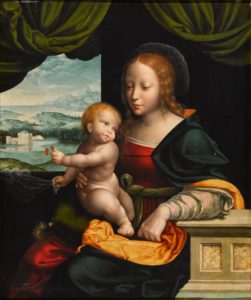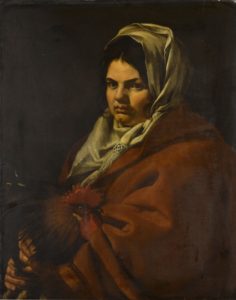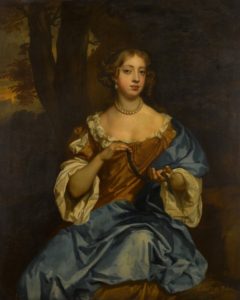
The Madonna of the Cherries from the Workshop of Joos van Cleve
In early February, I wrote about a Sotheby’s New York Old Masters sale where the star item was Sandro Botticelli’s Christ portrait known as The Man of Sorrows. While that sale brought in $76 million (or $91 million w/p), it barely crept past the total minimum estimate. I wondered whether Old Masters as a category was facing a brief period of decline, as some other analysts have noted. The sale, I wrote, “seemed a bit lackluster given the names attributed to the works.” But this week’s online Old Masters sale at Sotheby’s London location let us all know that the category is still chugging along (w/p = with buyers premium).
Sotheby’s specialists seemed very excited about one particular oil-on-panel work from 1540. It came out of the Antwerp workshop of the Dutch master Joos van Cleve. It’s a Madonna and child painting commonly known as The Madonna of the Cherries. In the sixteenth century, this was a particularly popular subject originally conceived by Leonardo da Vinci. While the Leonardo work is now lost, different copies and adaptations, like the one by Giampietrino, give today’s audiences a sense of what the original may have looked like. While the Van Cleve work is a lovely Madonna and child, it seems a little underwhelming compared to the Giampietrino copy. It’s even underwhelming compared to other Van Cleve versions of the subject. The Van Cleve Madonna of the Cherries from Hester Diamond’s private collection is miles better (in my opinion) than the one sold at Sotheby’s on Wednesday. One only needs to look at the titular cherries. In the Giampietrino and the other Van Cleve copies, the viewer can perceive their roundness, a gleam indicating a light source reflected in the skin. But with Van Cleve’s workshop, they’re nothing but small, red dots that look more like holly berries than cherries. There’s also the texture of the Madonna’s hair and the use of sfumato in the mountainous background. The work brought in £80K / $104.4K (or £100.8K / $131.6K w/p), hitting its high estimate right on the nose. But while the Van Cleve Madonna was the work most highly valued by Sotheby’s specialists, it reached only the third-highest hammer price for the sale. Two other pieces flew right past and exponentially exceeded their respective estimates.

A Peasant Woman Holding a Cockerel
The top spot for the sale, the biggest surprise of them all, belonged to A Peasant Woman Holding a Cockerel, created in the seventeenth century by an unknown artist likely from Northern Italy. While only estimated to go for £6K to 8K, dozens of bids allowed the simple portrait to sell for fifteen times its high estimate at £120K / $156.7K (or £176.4K / $230.3K w/p). Similarly, Sir Peter Lely’s Portrait of Letitia, later Lady Russell took second place after tripling its high estimate and selling for £90K / $117.5K (or £113.4K / $148K w/p). The Dutch-British portraitist created the work for Letitia Russell, the granddaughter of the Duke of Bedford. Both Letitia and A Peasant Woman were previously in the private collection of the Hill family, who have held the title Marquess of Downshire since the 1780s. While A Peasant Woman was a big enough surprise to come out on top, it wasn’t the only surprise at the auction. Peter Monamy’s nautical scene, The Royal Yacht Dublin, shows the titular ship used by Queen Anne, George I, and George II when travelling across the Irish Sea. A royal trip to Dublin didn’t take place too often, so it was more commonly used by the monarch’s Lord Lieutenant of Ireland. Sotheby's experts expected the work to fetch £8K maximum but reached over nine times that when it sold for £75K / $97.9K (or £94.5K / $123.4K w/p).

Portrait of Letitia, later Lady Russell by Sir Peter Lely
Towards the end of the sale, Sotheby’s mixed in some pieces from different genres, nineteenth-century paintings in this case. In all, the sale featured thirty-one nineteenth-century works. Most of them were sporting scenes by British painters like Ben Marshall and John Ferneley, with plenty of red-coated riders on horseback accompanied by their dogs. This was to increase the nineteenth-century pieces’ exposure to the Old Masters crowd since nineteenth-century paintings may not be doing particularly well at the moment. However, it’s also because, as time goes on, nineteenth-century works are slowly getting incorporated into the Old Masters categories. While it wasn’t the case a few decades ago, some of the great romantic artists like Delacroix and Géricault are now sometimes lumped into the Old Masters genre. So perhaps buyers will find more British sporting painters like John Frederick Herring regularly featured in Old Masters sales in the future.
Sotheby’s experts expected the entire sale to bring in between £1.2M to £1.7M. The auction as a whole brought in £1.36M (or $1.8M), which is on the lower end of the estimate range, but within the estimate nonetheless. Despite many of the works being attributed to unknown artists (like A Peasant Woman), 58% of the 176 available lots hit or exceeded their estimates. So perhaps the greater integration of Old Masters and nineteenth-century genres could be the thing that revitalizes the two markets.
Sotheby’s Old Masters Online Sale
The Madonna of the Cherries from the Workshop of Joos van Cleve
In early February, I wrote about a Sotheby’s New York Old Masters sale where the star item was Sandro Botticelli’s Christ portrait known as The Man of Sorrows. While that sale brought in $76 million (or $91 million w/p), it barely crept past the total minimum estimate. I wondered whether Old Masters as a category was facing a brief period of decline, as some other analysts have noted. The sale, I wrote, “seemed a bit lackluster given the names attributed to the works.” But this week’s online Old Masters sale at Sotheby’s London location let us all know that the category is still chugging along (w/p = with buyers premium).
Sotheby’s specialists seemed very excited about one particular oil-on-panel work from 1540. It came out of the Antwerp workshop of the Dutch master Joos van Cleve. It’s a Madonna and child painting commonly known as The Madonna of the Cherries. In the sixteenth century, this was a particularly popular subject originally conceived by Leonardo da Vinci. While the Leonardo work is now lost, different copies and adaptations, like the one by Giampietrino, give today’s audiences a sense of what the original may have looked like. While the Van Cleve work is a lovely Madonna and child, it seems a little underwhelming compared to the Giampietrino copy. It’s even underwhelming compared to other Van Cleve versions of the subject. The Van Cleve Madonna of the Cherries from Hester Diamond’s private collection is miles better (in my opinion) than the one sold at Sotheby’s on Wednesday. One only needs to look at the titular cherries. In the Giampietrino and the other Van Cleve copies, the viewer can perceive their roundness, a gleam indicating a light source reflected in the skin. But with Van Cleve’s workshop, they’re nothing but small, red dots that look more like holly berries than cherries. There’s also the texture of the Madonna’s hair and the use of sfumato in the mountainous background. The work brought in £80K / $104.4K (or £100.8K / $131.6K w/p), hitting its high estimate right on the nose. But while the Van Cleve Madonna was the work most highly valued by Sotheby’s specialists, it reached only the third-highest hammer price for the sale. Two other pieces flew right past and exponentially exceeded their respective estimates.
A Peasant Woman Holding a Cockerel
The top spot for the sale, the biggest surprise of them all, belonged to A Peasant Woman Holding a Cockerel, created in the seventeenth century by an unknown artist likely from Northern Italy. While only estimated to go for £6K to 8K, dozens of bids allowed the simple portrait to sell for fifteen times its high estimate at £120K / $156.7K (or £176.4K / $230.3K w/p). Similarly, Sir Peter Lely’s Portrait of Letitia, later Lady Russell took second place after tripling its high estimate and selling for £90K / $117.5K (or £113.4K / $148K w/p). The Dutch-British portraitist created the work for Letitia Russell, the granddaughter of the Duke of Bedford. Both Letitia and A Peasant Woman were previously in the private collection of the Hill family, who have held the title Marquess of Downshire since the 1780s. While A Peasant Woman was a big enough surprise to come out on top, it wasn’t the only surprise at the auction. Peter Monamy’s nautical scene, The Royal Yacht Dublin, shows the titular ship used by Queen Anne, George I, and George II when travelling across the Irish Sea. A royal trip to Dublin didn’t take place too often, so it was more commonly used by the monarch’s Lord Lieutenant of Ireland. Sotheby's experts expected the work to fetch £8K maximum but reached over nine times that when it sold for £75K / $97.9K (or £94.5K / $123.4K w/p).
Portrait of Letitia, later Lady Russell by Sir Peter Lely
Towards the end of the sale, Sotheby’s mixed in some pieces from different genres, nineteenth-century paintings in this case. In all, the sale featured thirty-one nineteenth-century works. Most of them were sporting scenes by British painters like Ben Marshall and John Ferneley, with plenty of red-coated riders on horseback accompanied by their dogs. This was to increase the nineteenth-century pieces’ exposure to the Old Masters crowd since nineteenth-century paintings may not be doing particularly well at the moment. However, it’s also because, as time goes on, nineteenth-century works are slowly getting incorporated into the Old Masters categories. While it wasn’t the case a few decades ago, some of the great romantic artists like Delacroix and Géricault are now sometimes lumped into the Old Masters genre. So perhaps buyers will find more British sporting painters like John Frederick Herring regularly featured in Old Masters sales in the future.
Sotheby’s experts expected the entire sale to bring in between £1.2M to £1.7M. The auction as a whole brought in £1.36M (or $1.8M), which is on the lower end of the estimate range, but within the estimate nonetheless. Despite many of the works being attributed to unknown artists (like A Peasant Woman), 58% of the 176 available lots hit or exceeded their estimates. So perhaps the greater integration of Old Masters and nineteenth-century genres could be the thing that revitalizes the two markets.